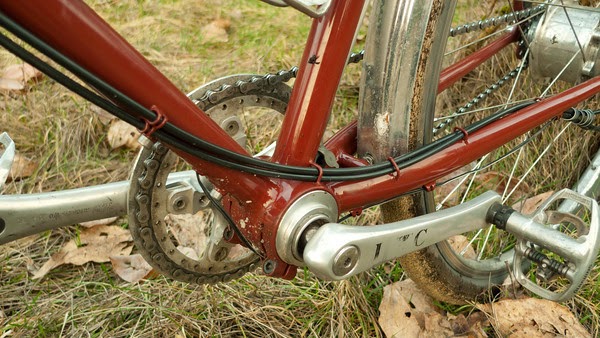Soma's designers certainly had disk brake cables in mind when they drew up the Wolverine. There are braze-ons along the top tube and down the seat stay for the rear brakes and more braze-ons down the fork blade for the front. These braze-ons use common C-clips to hold the hoses, and Soma even provided the clips with the frame.
Rohloff shifter cables are another story and routing them presents a problem needing resolution. The Wolverine frame has bosses for downtube cable stops and a cable guide under the bottom bracket shell ... derailleur-ready ... not Rohloff-ready. The stock Rohloff twist shifter uses two cables that run in tandem to the non-drive side of the rear hub. Soma didn't include any guides to run one, let alone two, such cables to that location. I need to get creative on how to run the cables and how to secure them to the frame. Another issue stems from my desire to run full housings the whole way, while the existing bosses and guide cater to bare cables.
I plan to utilize the bosses on the upper part of the down tubes as described in this post. A dual cable guide (like the one pictured) located on the lower end of the downtube can secure things to that point, but, where do the cables go from there?
I'm considered three options and have yet to decide:
1) Run both shift cables under the bottom bracket and along the underside of the chainstay. This option hides the cables best, giving a cleaner look.
2) Route both cables over the bottom bracket and along the top of the chainstay. This option allows for more gentle curves in the cables for smoother shifting.
3) Run one cable under the bottom bracket and along the underside of the chainstay, and one cable over the bottom bracket and along the top of the chainstay.
Finally, how should the cables be secured along the chainstay? Given the uneven and nonstandard diameter of chainstays, no elegant clamp-on cable guides exist, so I'm limited to either stick on C-clip guides (first picture below) or some sort of zip tie solution. I also considered using thin strips of two-sided tape under the cables. In the end, using stick-on anything seems too temporary for something that demands a more permanent approach. Zip ties it is, and Rohloff happens to produce a dual-cable clip (second picture below) that zip ties on.






I'd go with Option 2. Smoother shifting and better protected. I plan the same build but with an Alfine.
ReplyDeleteBeing better protected is a good point I hadn't considered. Thanks.
ReplyDeleteThis comment has been removed by the author.
ReplyDeleteThank you for this blog! I'm in the process of building a Wolverine myself (well, actually just getting misc. parts for now because of my low budget) and I've learned so much from your writing. I didn't even realize the cable routing issue and the need for separate disc brake adapters before.
ReplyDelete